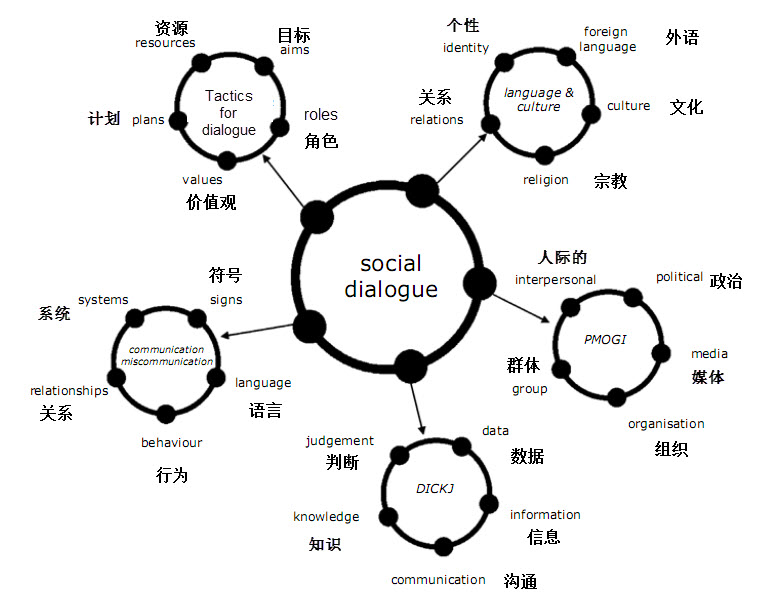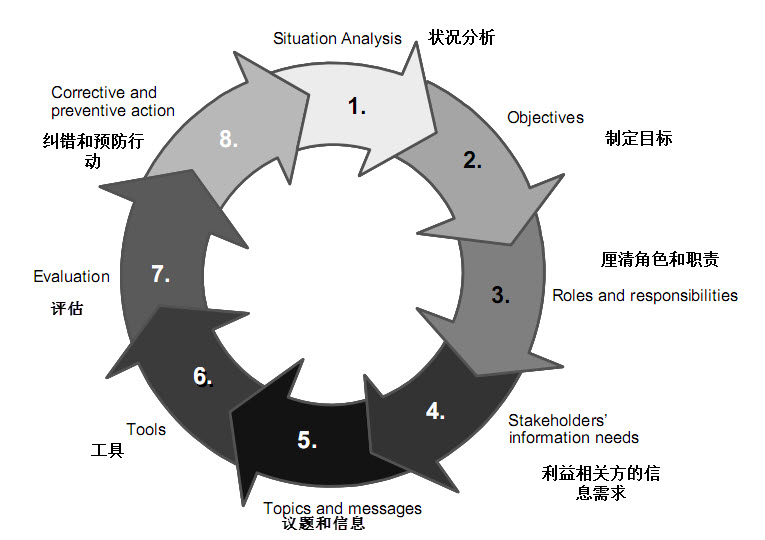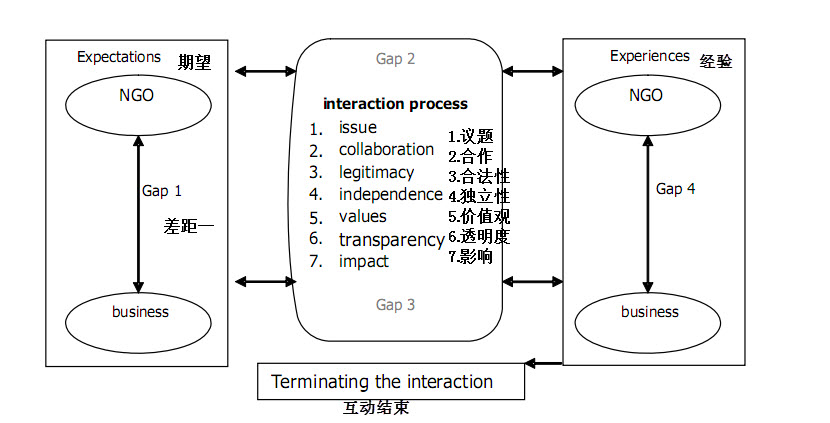在将CSR落实到企业与各方互动这一部分中,有不少的关于企业是如何与各方进行沟通、对话,以调整彼此的期望的。除了第一个模型之外,其他都比较简单。是以整合为一个。
On Dialogue: A Self-Development Tool
一个对话模式的25个要素。这25个要素其实不单单用于对话,也可以用一个项目非常详尽的分析。如果事事如此,事情可能会很顺,但是那还不累死么……

Languge & Culture 语言与文化
外语:该语言代表的是哪个群体?在这些语言背后的假设是什么?支配的理念是什么?从当前讨论的信息中我们能学到什么?
文化:不同的文化如何影响对话?我们自身的文化假设是什么?主流价值观是什么?文化价值观中包含哪些?我们怎样使用文化改善生活?
宗教:Which religious groups are represented? How do their values differ? What critical values are important to the dialogue? How may these affect outcomes? What principles can we agree? 该宗教代表哪些群体?他们的价值观有何不同?在对话中关键的价值观是什么?这些是如何影响到结果的?我们同意哪些价值观?
关系:Which relationships do we all hold important? Who doesnot attend the event? Who is overly powerful? How might they influence the dialogue? What people should we take particular care of? How do we value our relationships? 我们认为那些关系是重要的?谁没有参加到活动中?谁的权力过大?他们会如何影响对话?什么人需要特别关注?我们该如何评估我们的关系?
个性(这里也可以译为身份,个人角色认同等):How do individual notions of identity affect our interactions? What can we learn from individual view points? How do we understand the link between relationships and identity? How are fragmented identities dealt with fairly? How does the community support the individual? 个人的主张是如何影响到我们的互动的?从个人观点中我们可以学习到什么?我们是如何理解关系和个性间的联系的?如何公平地对待碎片化的个性特征?社区怎么支持个人?
PMOGI 交际关系模型
政治:What political structures are involved? Who controls them? How can they benefit? How do they disturb the dialogue? Are people protected from outmoded forms of political association (i.e. are dialogue participants self-governing?) are principles of self-governance, or self-determination open for discussion? 什么样的政治结构与此相关?谁控制(统治)它(他)们?又如何获益?它们是怎样干扰了对话?人们是否受政治组织过时制度的保护(也就是对话参与者能够实现自我管理否?)自我管理或自我决定的原则是可公开讨论的么?
媒体:Which media may inform the dialogue? How can they affect dialogue participants positively or negatively? Is the medium the message? How can media be used to build dialogue? How much information is necessary and how much more required? 哪种媒体会公开(报道)对话?它们会对对话参与者造成什么积极或消极的影响?是否媒介即信息?如何利用媒体建立对话?必需的信息有多少?还需要哪些?
组织:Do organisations dominate the dialogue? Is the dialogue free from coercion or interference by organisations? Are organisation assumptions similar to participant assumptions? Are organisation structures outmoded in the network model of information? Are organisations able to deal with individual concerns without resort to ‘disciplinary’ behaviour? 组织者对话中是否处于支配地位?对话可以不受来自组织的压制或干涉吗?组织的设想是否与参与者的设想相似?组织结构中信息网络模型中是否过时?组织能否妥善解决个人所关心的问题?
群体:Can the group agree a clear process for managing its dialogue? Can it work with other groups? Are leaders necessary? Are followers able to affect leader decisions? Is an ethical process of group discussion established?群体会认同一个清晰的对话管理流程么?其他群体也同样可行么?需要领导者么?追随者们能否影响领导的决策?群体讨论的伦理过程是否建立了?
人际:Can individuals affect the dialogue? Are individual concerns met? Are solutions that are creative accepted in the dialogue? Does dialogue analysis value individuals? Do the other structures of the PMOGI model respond to individual concerns? 个体是否可以影响对话?个体关注是否已经满足?在对话中,创造性的解决方案会被接受么?对话是否尊重了个体?PMOGI模式的其他组织会回应个体的关注么?
DICKJ
数据:How is data collected? By whom? What are the assumptions of its collection? Who is in involved in its capture and dissemination? How can new data capture techniques beemployed to support dialogue? 数据是如何收集的?谁收集的?数据收集的假设是什么?哪些人参与了数据的获取和传送?新数据获取的技巧如何用于支持对话?
信息:Where is the information from? Who controls it? In whose benefit does it work? When is information re-interpreted? Are information systems 100% transparent? 信息从哪里来?谁控制?信息会让谁受益?何时对信息进行重新解释?信息系统是否百分百透明?
沟通:Is all communication open to changed assumptions? How is communication used to benefit people? Who controls communication? How can individuals and groups affect communication with political, media and organisation systems? How is communication ethical?是否就那些已经发生变化的假设进行过交流?人们如从交流中受益?谁控制了交流流程?个体和群体是如何通过政治、媒体和组织系统来影响沟通的?如何让沟通伦理化?
知识:Who claims knowledge of a subject? What principles is the knowledge founded on? Have these been examined? What techniques have been used in knowledge formation? And how is new knowledge accounted for? 谁需要某一主题的知识?知识建立在何种原则之上?知识经过检验么?在知识形成中,使用了哪些技术?如何对新知识进行解释?
判断:Whose judgements prevail? Are these historical judgements? How can judgements be reversed even if benign? If the community decides new judgements are necessary, then how can old agreements be updated? 谁的判断处于支配地位?这些判断是历史性的么?如何推翻原有判断,即使判断是良性的?如果社区决定新的判断是必须的,那么原有的协议该如何更新?
Communication – miscommunication 沟通 – 误沟通
符号:How does symbolic communication operate in the dialogue? What symbols are used? Who owns the symbols? Can they be used by the community? How can symbolic (graphic-visual-behavioural) communication be improved?对话中如何使用符号进行交流?应用哪些符号?谁拥有这些符号?社区能否使用这些符号?如何改进这些符号性(图像-视觉-行为)的交流?
语言:What assumptions operate in the languages used in the dialogue? How do people use terms? What technical vocabularies are used? How can new language ideas/words be included in community learning? What terms control and/orreduce lifeworld concerns?在对话所应用的语言中使用了哪些假设?人们如何使用术语?使用什么样的技术性词汇?社区学习中使用哪些新语言的思想/语汇?什么样的术语能够控制或减少现实生活中的忧虑?
行为:参与分析的行动中和听众表现如何?他们是否公开和诚实?能够做出改变么?他们囿于己见么?他们能够协同合作么?
关系:沟通中关键关系有哪些?如何理解这些关系是重要的?如何改进或改变这些关系?哪些人在限制对话?哪些人的利益受到关注?那些人的利益不被关注?
系统:哪些影响力的系统(技术、媒体、运营operations、资源等)降低了对话的可能性?如何反过来影响它们?谁控制它们?它们能否做到100%的公开透明?如何衡量变化的时机,即技术的效果是怎样减缓或降低变化的?
Tactics for dialogue – short form for complete dialogue对话策略-完全对话的简要形式
目标:对话的目标是什么?对话是否公正?是否平衡?谁被赋予了特权?谁被剥夺了权利?
角色:谁参与了对话?谁没有?如何识别(区别)社区?人们如何参与其中?用什么方法对人们进行保护?是否需要强制进行?
价值观:人们持有什么样的价值观?为什么?如何将这些价值观考虑进去?谁来保护哪些”不被衡量”(that cannot be measured)的价值观?事实和价值观之间有什么不同?
计划:为了改进目标要制订什么样的计划?谁来实施?有哪些可能的选择?计划得到所有参与者同意么?为何没有?原因是什么?
资源:有哪些资源是必要的?我们如何衡量成功?由谁提供资源?公平么?资源管理是否限制了对话?如何通过进一步对话来监管资源?
Stakeholder Engagement: The Experience of Holcim
这个模型其实蛮简单的。

- 分析状况:目前状况如何?从公司视角看呢?从利益相关方看呢?
- 确定目标:要确定什么目标?目标是否可衡量(可测量)?
- 确定内部角色和责任:谁要做什么?为何?
- 界定利益相关方并评估他们对于信息的需求:谁是你的利益相关方?他们有什么样的需求和期望?
- 提出相关主题的关键信息来满足这些需求:是否选择了一些受众,对这些信息是否容易理解进行测试?
- 使用最合适的利益相关方参与方式:对话(一对一或对群体)、社区咨询委员会、公开听证、焦点小组等。是否准备好参与其中?
- 评估利益相关方参与的计划:公司陈述的目标实现了么?
- 建立纠错和预防措施:会按照利益相关方的建议行事么?会改变一些战略的方面来迎合利益相关方的需求么?
DOs:
- Have a clear, well-articulated objective;
- Be realistic – do not start what you cannot finish;
- Allow enough time for planning, planning and more planning;
- Be aware and manage expectations – both yours and your stakeholders’;
- Start thinking about the longer term engagement process early, and consult your stakeholders on what they want in terms of continued communication;
- Focus on quality, not quantity – participants should be invited on the basis of their credibility and ability to be thought-provoking;
- Acknowledge genuine differences. Everyone should make an effort to
share perspectives, listen and learn; - Be prepared to be as open and transparent as possible;
- Aim to build joint ownership for actions toward change;
- Ask the right questions – be flexible and open to improvising based on stakeholder needs;
- Be ready for a messy, time-consuming process;
- Listen!
Managing Expectations in Partnerships
这是一个适合NGO与企业间的沟通模式。以下的BNI模式(Business-NGO Interaction)包含这7个要素/指标。每个指标都应该含有35个封闭式的问题(每个问题有7个点来衡量,即从最好到最差分为7个点),然后进行打分。书中并没提供这些问题。但是以下7个指标也可供企业与NGO的互动进行参考。
In order to start measuring these expectations in a systematic way, the relevant concepts were derived from a literature study with respect to stakeholder theory and partnerships (Bendell, 2000; Zadek, 2004) and from interviews with NGOs and companies. These concepts gave way to seven criteria that were further elaborated in a list of indicators which is presented below:
- Issue: The first criterion concerns the issue around which the parties intend to engage. This criterion is operationalised into indicators such as the rationale of the parties to get involved with each other and the degree of shared recognition of the problem(s) at hand.第一个标准就是有哪些议题是各方想要参与其中的。
- Representativeness: The second criterion focuses on the legitimacy and representation of actual persons that will exemplify the contact betweenthe parties. The first indicator refers to the critical mass (in terms of competencies, professionalism and organisational resources) necessary to be perceived as a relevant and potentially satisfactory partner. Other indicators are the complementarity and recognition of capabilities and resources and the personal authority of the contact persons to make decisions that imply commitment for the organisation as a whole. 第二个标准是注重实际参与人的合法性和代表性,可以作为各方间接触的例证。
- Values: The third criterion addresses the underlying values of the parties involved. It is assumed that a basic level of trust at the start needs to be plain in order to be able to engage in a constructive and fruitful dialogue. During the actual process of collaboration around a specific issue, the level of trust needs to be developed in order to foster the relationship. Indicators that contribute to trust are long-term commitment and respect for different value systems and worldviews between the different parties. 参与各方的价值观。
- Collaboration: A fourth element in the mutual expectations of NGOs and companies relates to the recognition of the rules of the game. Important indicators relate to operational co-ordination and sharing of risks. Furthermore, the awareness of and flexibility to respond to changing environmental demands, and past experiences of the parties involved in similar processes need to be taken into account. 非政府组织和公司间对彼此期望的第四个要素,对互动规则的认知。
- Independence: Collaboration influences by definition the independent position of the parties involved. Therefore the fifth criterion focuses on the risks that can accompany close contacts between NGOs and business, showing the reverse-side of collaboration. Relevant indicators are the loss of legitimacy and credibility of the NGO if its support is derived from a critical stance towards business, misuse of information, and expectations about practices of NGOs to take action while being in dialogue with a company.合作会影响参与各方的独立地位。
- Transparency: The sixth criterion deals with the transparency of the future collaboration. Sharing relevant and useful information beforehand and during a project is a prerequisite for effective interaction. This will enhance trust building, and enable understanding of the often different worldviews. Indicators provided by literature are: the reliability of the exchanged information, the possibility for third-party or other forms of external verification, and the nature of the (joint) communication with other relevant actors.关于未来合作的透明性。
- Impact: The last criterion points at the impact that both parties aim for and what is actually achieved. Impact refers to possible direct and indirect results, and is as such crucial in the development of patterns of expectation. Indicators are: linkage of activities with the core business of the organisation, clarity of common understanding of goals and results at the start, demonstrable achievement of results, and mutual learning. 双方所要实现和实际实现的影响。
